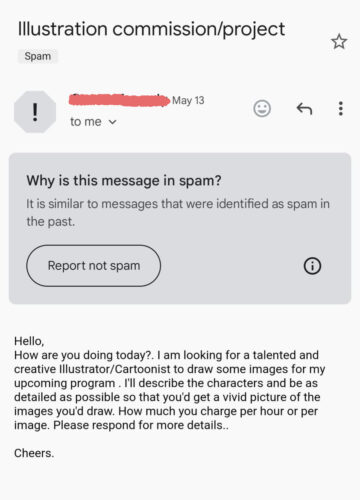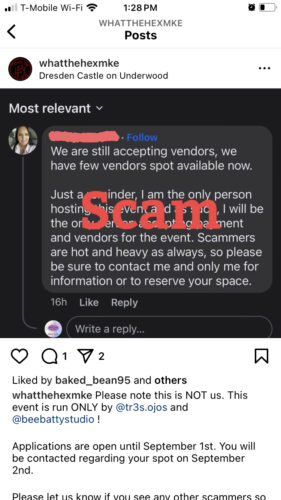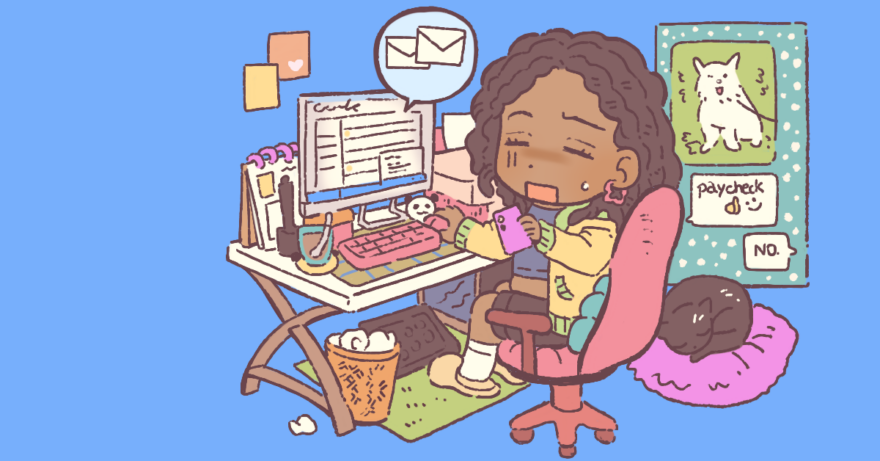Written by Virginia Paine
Illustration by Pa-Luis
Scamming is a universal experience for artists of all levels but it’s an issue that can be mitigated with knowledge. I’m happy to share what I’ve learned, some tips to prevent getting scammed and two examples of recent scams I’ve seen.
I have two rules of thumb when it comes to scam awareness. First, absolutely trust your gut. If you don’t feel comfortable in a situation, don’t do it. No commission will be worth it. A good, professional client will not dodge questions, refuse contracts, or demand sensitive information from you.
Second, knowledge is your friend. Knowing what kinds of scams target artists is the key to telling the difference between actual clients and people taking you for a ride.

Some red flags to look out for include:
- Asking for a rush job
- Providing way too much unnecessary info (such as medical history, personal details) or not enough info (nothing about format, size, theme, etc.)
- Broken English (use your discretion; not everyone speaks English but scammers often use this)
- Weird formatting or punctuation
- Insisting on verbal agreements
- Weird payment methods such as checks, cashier’s checks, money orders or money transfers. There are enough payment systems (like PayPal and Venmo) that clients should be able to pay quickly and accurately
The best way I’ve found to check a message I’ve received is to copy the message’s text and paste it into the search bar with “scam” at the end. Usually an existing scam will pop up in the search results because someone else has received the same message verbatim.
For example, here is an email I received last year asking for an illustration:
“I’m celebrating my uncle’s wedding anniversary and I want a professional illustrated invitation card design. It is somewhat difficult for me to Illustrate designs that are appealing. I work as a ship steward, consistently attending to passengers and individuals.
I’m currently under a lot of pressure to organize everything on my own. The illustration design will also be customized on our T-shirts. So that’s the reason I’ve reached out to you on the project and I hope you will do a fantastic job.
The delivery date/deadline for the submission of the Illustrations is no later than December 28th and the project has a budget of $600.
Below are the words which will be composed in the Illustration On the Card.
Welcome To Barry & Tina’s Wedding Anniversary Ceremony
Event Date: January 5th, 2024
The Venue: The Hall on Dragon
Address: 1500 Dragon St, Suites C&D, Dallas, TX
Time: 12:30pm – 5:30pm
Redwood is the preferred color
• The invitation size will be 5 x 7
Finally, for reference and clarification, I can send a sample of preferred designs and our photo shoot which will be illustrated….Kindly let me know any other details needed moving forward.
Hope to read from you soon.”
In this email we have a bunch of items that set off alarm bells. First was the turnaround time; this person sent me this email on November 20th for a project that had to be done by December 28th. That’s a tight window for art and revisions, especially since the person is claiming they will get t-shirts printed in the brief window between completion and the event date. Second, the unnecessary details about the person’s job. It’s odd to mention that you are a ship steward and what it entails when it has nothing to do with the commission. While the venue’s name may seem bizarre, I looked it up and it is an actual venue in Dallas.
It’s strange to ask me to do an illustration with a lot of writing as well; it’s not like my website has a lot of examples of my hand lettering or graphic design.
Other weirdness: “redwood” isn’t a color that springs readily to most people’s minds. That and the sign-off “hope to read from you soon” are examples of the broken English commonly used by scammers.
Furthering my suspicions, this person told me the timeline was “flexible” when I said I couldn’t do that tight of a turnaround. How flexible can it really be if the event has a set date? When I responded that I wouldn’t have time until late February, the commissioner stopped responding.
We all know that working in the arts is a struggle in terms of money. It’s easy to get discouraged and equally easy to want to believe in a quick fix for our financial problems. This is a completely understandable wish, especially in the US, a place that has a long and storied history of get-rich-quick myths and scams. Because artists are often in a vulnerable economic position, we are particularly targeted by scams of all kinds.
Here I’ve chosen to highlight two recent scams targeting artists: the “pet portrait” scam and the convention/market tabling scam. This should enable you to spot them if you get approached.
Pet portraits
A member of the Milwaukee Artists Group I’m part of (mkeartists.org) was approached by someone looking for a commission.
“I had someone reach out to me in [September] of last year looking for a pet portrait ‘in your style.’ … I quoted them the cost and explained I take half up front and the other half + shipping once complete. They insisted they would pay the whole amount up front. This wasn’t really a red flag as I have had others do this before. I responded something to the effect of ‘That sounds great! I will get an invoice sent your way and get started. Would you like me to send it directly to your email or here in messages?’ Then I was hit with the ‘do you take check’ and ‘I can send you more’ and I knew I had just wasted my time. It was very disheartening.”

This is a variation of an old scam that uses overpayment to trick you into giving the scammer money. In the past it has been commonly used by scammers buying artwork or, when Craigslist was more widely used, pretending to agree to rent an apartment with their mark. The con artist will send you a check for payment, far more than the agreed upon amount.
Nowadays artists are often targeted by this type of scammer on Instagram. A stranger will DM to ask for a portrait commission, usually of a pet but sometimes a child. They will often offer a flat fee, more than what would usually be charged. I’ve seen examples of the scammers requesting large or unusually sized art. Often they will send several photos and include a bunch of extra or irrelevant info but will not respond to questions. The messages themselves will often be formatted strangely and use broken English.

They will offer to pay with a check or request your PayPal information. One artist in Milwaukee noted “…they wanted me to do a wire transfer which would be pretty hard to trace through a third party app like PayPal.” If they pay with a check, the check will be made out for more than the agreed-upon amount, and they will then ask you to send them the extra money back. This check itself will be fraudulent, from a fake bank or nonexistent address, and the return of the “extra” funds is how they’ll get paid. If they ask for your PayPal information, they are hoping to break into the account.
There are a couple ways to figure out if the commission request is fake. When looking at the person’s profile, it’s usually easy to detect a phony account if they have a strange follower/following balance, a bio that sounds copy/pasted, or if their feed contains stock-photo-looking images. A fake account might also have an odd display name (often two names and a string of numbers) or appear fairly new, with all the posts appearing to have been posted on the same day.
A reverse image search can be used to identify where the photos of the pets are actually from. Scammers will often just scrape random photos from the internet to serve as their pets. An example I saw used a bunch of shiba inu photos from a website dedicated to the breed.
The Convention Waitlist Scam

The Big Gay Market, a popular Madison-area artist market, have had to pin the following announcement to their Instagram page: “Scammers are now not only posting on our events, but directly messaging people. … We have an EXTENSIVE wait-list. We will not be posting online looking for vendors at this time. DO NOT message anybody but this account asking about the market. Don’t message strangers and do not send strangers money.”
There are a lot of new conventions and art markets popping up all over, and unfortunately this has become a new venue for scams. Similar to the type associated with online tarot readers or businesses offering giveaways on Instagram, this scam usually starts with someone who appears to be representing a convention or market the artist applied to but were not accepted to. They’ll DM saying that, surprise, a table has become available and they just need payment to secure the spot.
It’s important to always double check who the messages are coming from. Scammers often mimic official accounts but add an underscore or dash in the account name or handle. Some will even mention scammers and insist that they are the only ones who should be contacted about the event. A scammer impersonating What the Hex MKE, a Milwaukee witchy/goth market, on Instagram even said in a DM, “Scammers are hot and heavy as always, so please be sure to contact me and only me for information or to reserve your space.”

Most of the time, professional conventions and markets will NOT contact exhibitors through social media. Contact will occur through email and include official information including details like tabling contracts, payment options, deadlines, etc.
It’s important to let the actual account know they are being imitated, as it saves others from being targeted.
The best defense against scammers or even well intentioned but costly commissioners is preparation. Always insist on filling out an invoice and even a contract if it’s anything beyond just a personal commission. Invoices can be simple; most spreadsheet programs have invoice templates, and Paypal can generate invoices. For sample contracts, the Graphic Artists Guild Handbook is a fantastic resource. If you don’t have a copy of your own, the public library most likely will.
Ask for half payment up front when you are working with others. Include how many revisions you’re willing to accommodate, late fees, deadlines for payment, and any other assurances you feel will keep you sane.
It can be hard to want to ask for these things from people offering you money – you don’t want to lose a commission! But it’s worth it – you and your work are worth it – to demand these things from clients. If you stay aware and keep an eye out for offers that seem too good to be true, you can protect yourself, your art and your money.

Virginia Paine (virginiapaine.com) is a cartoonist and writer based in Milwaukee, WI. Their work has appeared in Bitch Magazine, ZEAL, The Fat Tarot and Fanbyte, among others.









